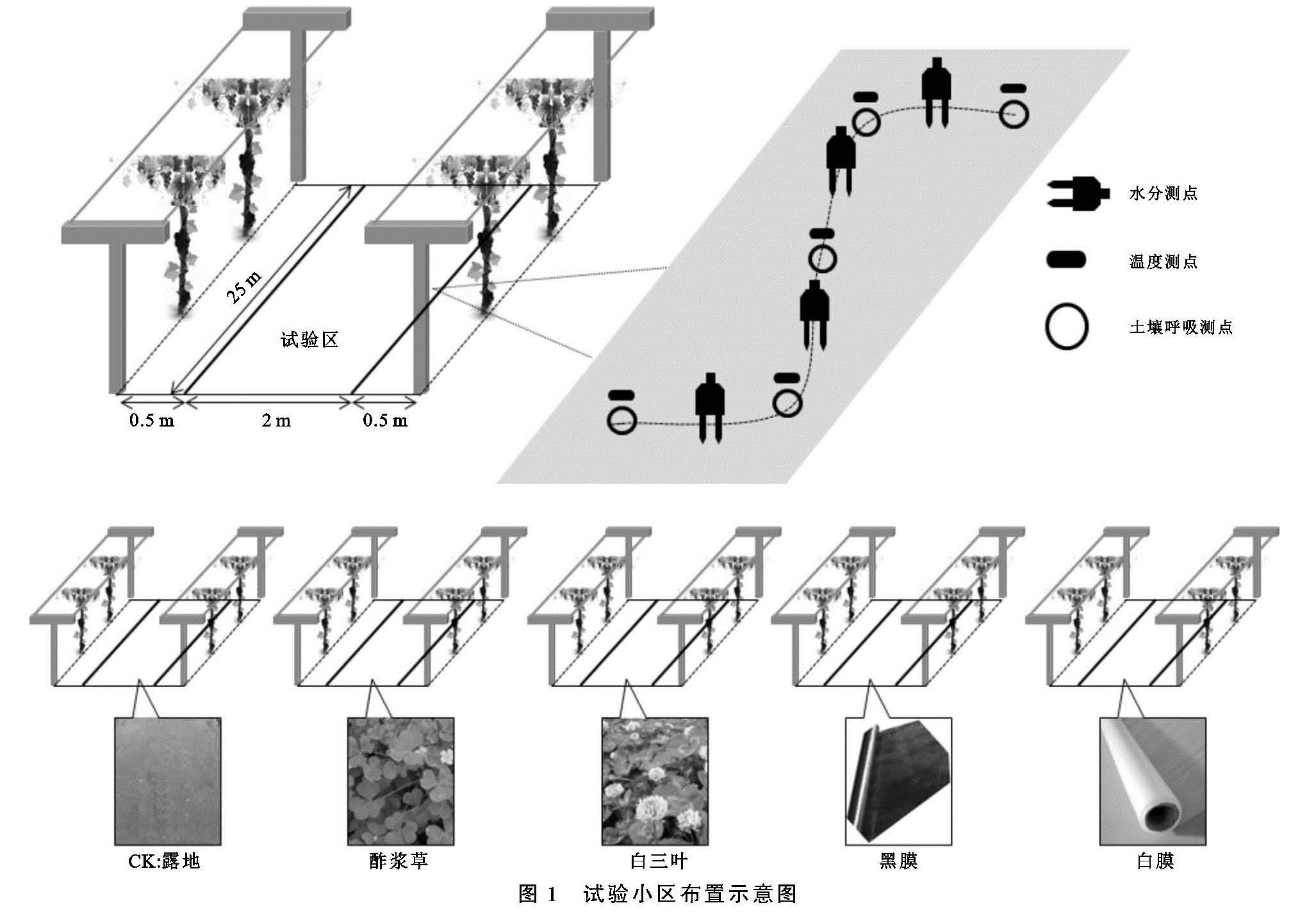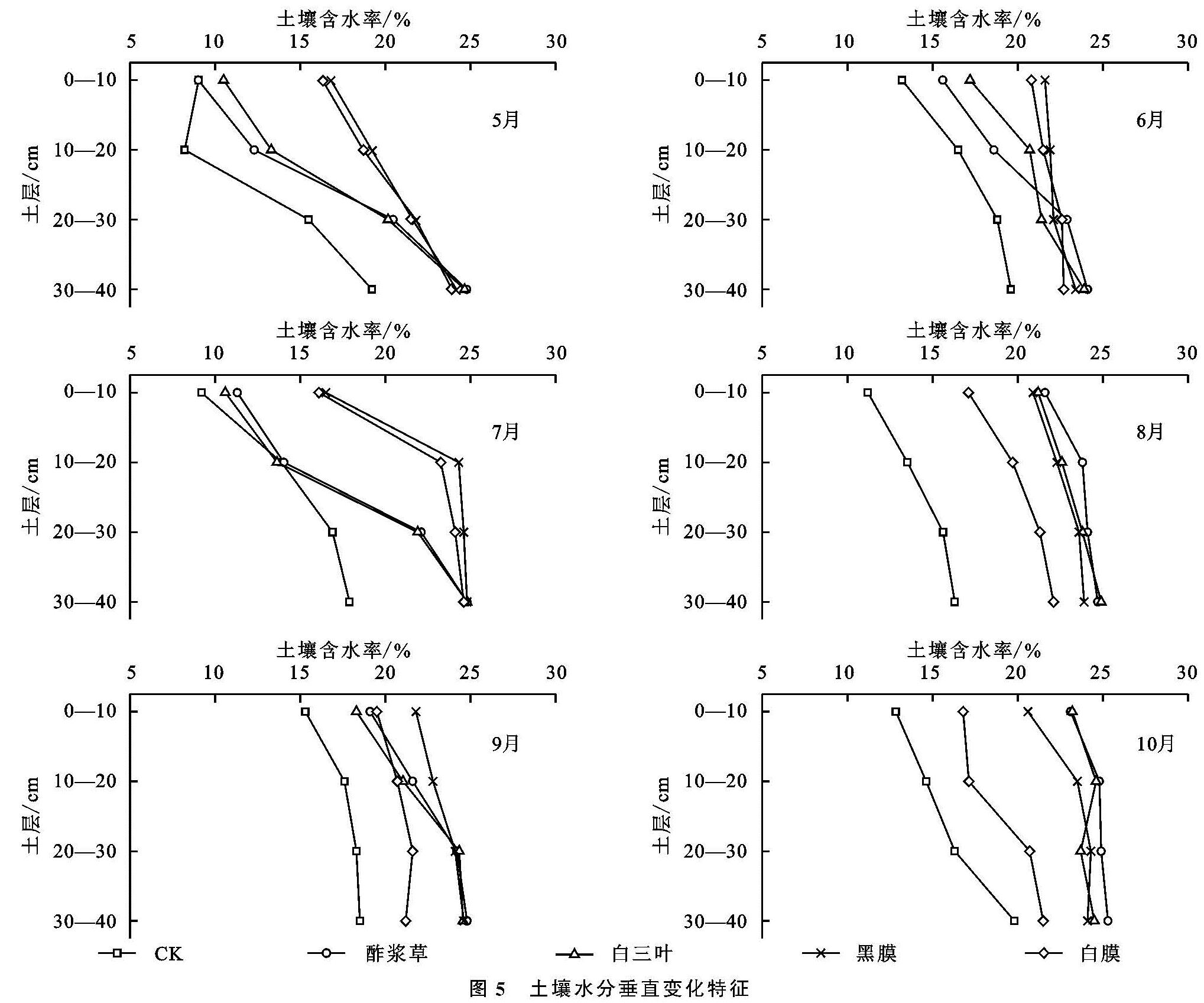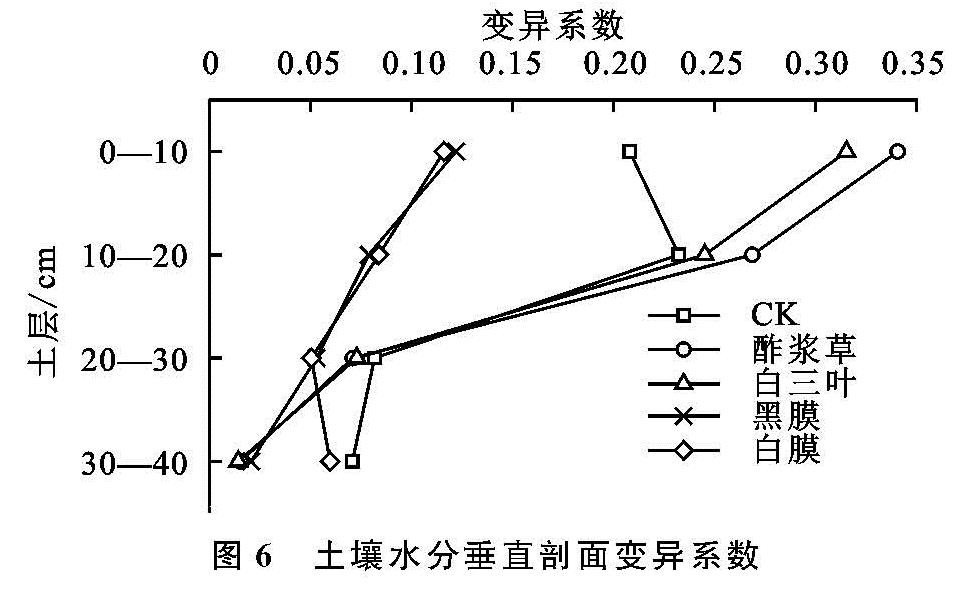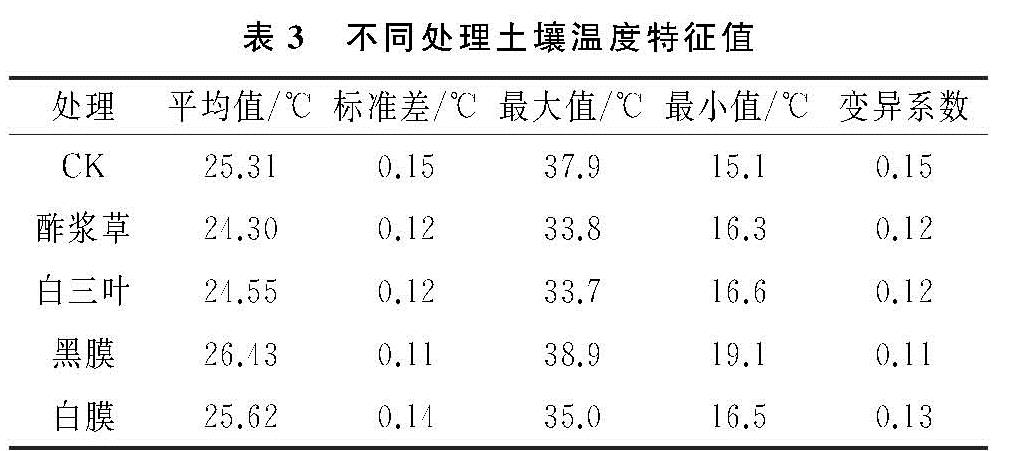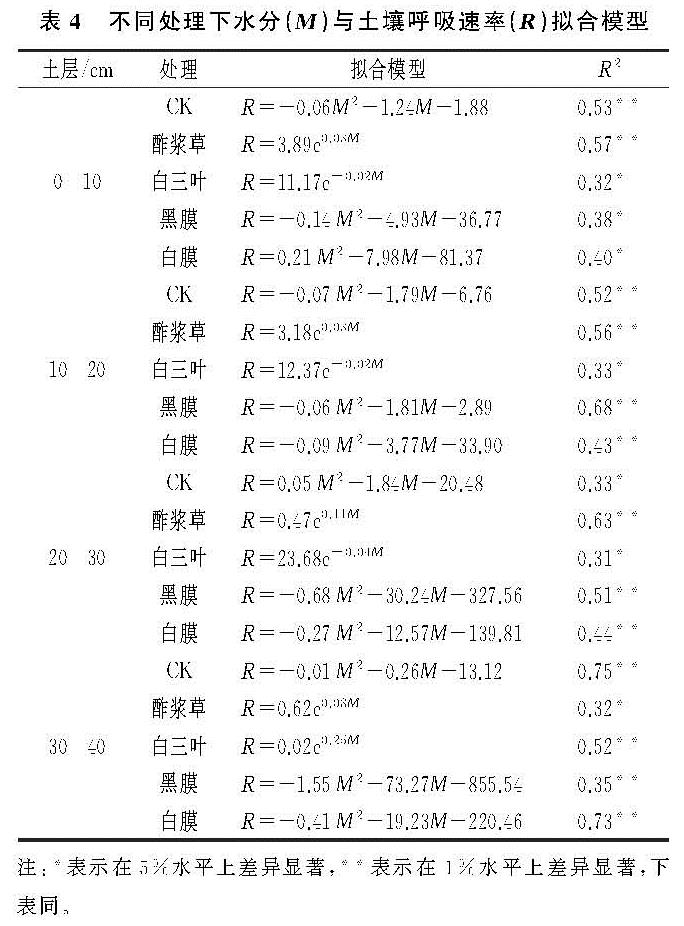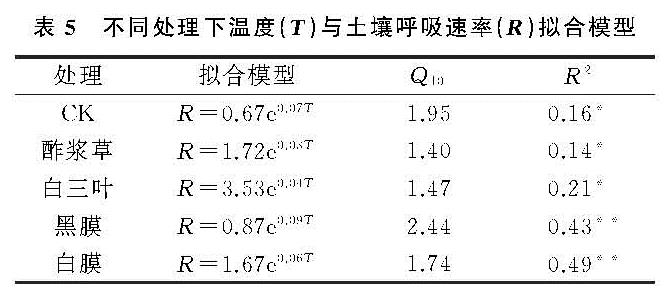2.1 土壤呼吸特征
对不同生长时期土壤呼吸数据资料分布情况进行总体分析,小提琴图(图4A)显示,CK土壤呼吸速率均值较低,白三叶覆盖处理下的葡萄园地土壤呼吸速率均值较高; CK土壤呼吸速率分布比较集中,其余处理(酢浆草、白三叶、黑膜、白膜)葡萄园地土壤呼吸速率分布较为离散,尤其以酢浆草和白三叶覆盖处理数据分布不够均匀,覆盖处理土壤呼吸速率存在较为明显的离散值。对不同覆盖处理葡萄园地土壤呼吸速率进行多重比较(LSR法)显示(图4A),各覆盖处理(酢浆草、白三叶、黑膜、白膜)相对于CK,土壤呼吸存在极显著差异(p<0.01),说明各覆盖处理均显著提高了CO2的排放速率。
分析不同时期土壤呼吸变化特征(图4B),在葡萄生产期(5—10月),各处理土壤呼吸均呈现出一定的峰值变化特征,总体表现为先增后减再增再减的变化趋势,各处理的峰值出现在8月,CK、酢浆草、白三叶、黑膜、白膜覆盖葡萄园地最大值分别为5.11,8.72,12.17,9.99,8.08 μmol/(m2·s)。而林下覆膜处理(黑膜、白膜)和林下生草(酢浆草、白三叶)处理表现出一定的时间变化异质性,林下覆膜分别在6月份(白膜覆盖)和7月份(黑膜覆盖)表现出短暂的局部下降趋势。各处理土壤呼吸在5—7月、9—10月变化速率相比7—9月期间较弱。白三叶覆盖处理相对于其他覆盖处理,在5—10月期间一直表现出较高的CO2排放速率。
2.2 土壤水分垂直变化特征
不同处理下的葡萄园地水分在不同时期呈现出较为明显的剖面垂直分异特征,且覆盖处理相比CK均表现出明显的水分保持能力(图5)。在5—10月,在0—40 cm土层内,随着深度的增加,土壤水分整体表现为增加趋势,下层土壤表现出较为良好的持水能力; 在30—40 cm土层上,各处理土壤含水率有不断接近,趋于稳定变化。5—7月,在0—30 cm剖面内,黑膜和白膜覆盖相比酢浆草、白三叶覆盖处理表现出较好的持水能力,而在30—40 cm土层区域内,酢浆草和白三叶覆盖处理开始表现出较好的持水能力。8—9月,在0—40 cm土层,酢浆草、白三叶、黑膜覆盖相比白膜覆盖表现出较强的持水保水能力。在5—10月,由于5月与7月份相比其他月份月降雨量较少(图3),因而各处理在0—40 cm土壤含水量相对较低,但下层土壤(20—40 cm)相比表层土壤(0—10 cm)表现出较高的含水量。
不同处理下的葡萄园地各土层层之间土壤平均贮水量显现出不同的变化规律(表2,图6)。不同覆盖处理下土壤0—10 cm土层内平均贮水量介于(11.79±1.00)~(19.70±0.98)mm,各处理与CK贮水量存在显著差异,黑膜贮水量显著高于其他覆盖处理,黑膜与白膜相比其他覆盖模式贮水量波动较小; 10—20 cm土层内平均贮水量介于(14.06±1.33)~(22.34±0.72)mm,酢浆草、白三叶、白膜覆盖贮水量差异并不明显,但与黑膜、CK组存在显著差异,且黑膜与白膜仍表现出较小波动,黑膜在该区域贮水量最高,且变异程度相对较弱; 20—30 cm土层内平均贮水量介于(16.90±0.56)~(23.38±0.51)mm,该层各处理与CK贮水量存在显著差异,但各处理之间差异并不显著,波动较为相近,该层的持水效果较为接近; 30—40 cm剖面内平均贮水量介于(18.56±0.54)~(24.75±0.16)mm,该区域内各处理与CK存在显著差异,CK与白膜覆盖表现出较强的变异性。
不同覆盖模式下,随着土层深度的增加,各区域的贮水量增加,地膜覆盖和生草覆盖相对于露地蓄水能力提升明显,在0—10 cm层,生草覆盖贮水量提升40.9%~42.7%,地膜覆盖提升50.7%~67.1%; 在10—20 cm层,生草覆盖贮水量提升36.4%~37.3%,地膜覆盖提升43.5%~58.8%; 在20—30 cm层,生草覆盖贮水量提升33.4%~36.7%,地膜覆盖提升30.3%~38.3%; 在30—40 cm层,生草覆盖贮水量提升32.3%~33.3%,地膜覆盖提升30.2%~22.1%。
2.3 土壤温度变化特征
不同覆盖处理下的葡萄园地温度(5 cm)在不同时期呈现出一定的差异特征(图7),各处理土壤温度特征值见表3。林下覆膜处理(黑膜、白膜)平均温度均高于CK,而林下生草覆盖处理(酢浆草、白三叶)平均温度均低于CK,林下覆膜处理增温效果整体强于林下生草覆盖处理。温度的最大值为38.9℃,出现在黑膜覆盖处理中,而最小值为15.1℃,出现在CK当中,黑膜的增温效果相对较强,而CK的增温效果最差。总体分析各处理5—10月土壤温度变化趋势,温度变化趋势和变化节点表现出较为相似的规律性,但局部的变化幅度和变异程度存在一定差异,变化峰值出现在9—10月份。黑膜覆盖处理的温度变异系数相比其他处理,表现为最小,而CK变异系数最大,这表明黑膜在维持土壤温度稳定(小变异系数)要优于其他处理,而露地维持温度稳定相对较差,除黑膜外,其他覆盖处理在维持土壤温度稳定方面为未表现出明显差异。
2.4 土壤呼吸速率对水热环境的响应
为了进一步探明不同覆盖处理下葡萄园地林下土壤呼吸对水分和温度的响应趋势,分别对不同覆盖处理的土壤呼吸和土壤水分、温度进行非线性回归[水分与呼吸速率回归模型见公式(1)—(3)选择较优模型,温度与呼吸速率回归模型见公式(5)]。
由表4可知,CK、黑膜、白膜覆盖处理土壤水分与土壤呼吸均呈现二次函数关系,其中CK处理在0—10 cm,10—20 cm,30—40 cm土层呈现极显著关系(p<0.01),在20—30 cm剖面呈现显著关系(p<0.05); 黑膜和白膜覆盖处理在0—10 cm土层呈现显著关系(p<0.05),在10—20 cm,20—30 cm,30—40 cm土层呈现极显著关系(p<0.01)。酢浆草和白三叶覆盖处理呈现显著指数函数变化关系,其中酢浆草覆盖处理在0—10 cm,10—20 cm,20—30 cm呈现极显著关系(p<0.01),在30—40 cm土层呈现显著关系(p<0.05); 白三叶覆盖处理在0—10 cm,10—20 cm,20—30 cm呈现显著关系(p<0.05),在30—40 cm土层呈现极显著关系(p<0.01)(表3)。酢浆草、白三叶覆盖处理土壤呼吸对各剖面水分呈现较为单一的响应变化趋势,而黑膜与白膜覆盖处理土壤呼吸对各剖面水分呈现出较为复杂的响应变化趋势,水分存在一定阈值变化响应关系。这些现象可能归因于不同覆盖处理下表层土壤与下层土壤生化环境的异质性。
由表5可知,各处理土壤温度(5 cm)与土壤呼吸速率呈现指数函数关系,其中黑膜与白膜覆盖处理表现出极显著(p<0.01)指数关系,而其他处理表现为显著(p<0.05)指数关系。这表明随着温度的增长,各处理土壤呼吸速率均表现为增长趋势。进一步分析各处理呼吸速率温度敏感系数(Q10),各处理温度敏感系数表现为:黑膜>CK>白膜>白三叶>酢浆草,在发生同样的温度变化扰动时,黑膜覆盖园地将比CK(露地)土壤将表现出更强的土壤CO2排放速率,而其他处理相对CK(露地)土壤将表现出较弱的CO2排放速率,其中白三叶覆盖与酢浆草覆盖园地呼吸速率温度敏感性相差较小。
表4 不同处理下水分(M)与土壤呼吸速率(R)拟合模型
表5 不同处理下温度(T)与土壤呼吸速率(R)拟合模型

